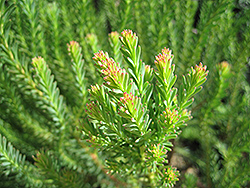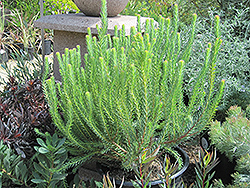Fri & Sat 8am - 8pm
Sun 8am - 7pm
Anytown, USA 12345
fax: 261.787.0463
e-mail: info@successgc.com


Plant Finder

Height: 4 feet
Spread: 4 feet
Sunlight:
![]()
Hardiness Zone: 8a
Description:
This flowering shrub, in the Protea family, features pale yellow flower heads in spring followed by attractive silver cones; abundant stems are covered with tiny, needle-like leaves that are tipped red when young; avoid phosphorus fertilizers
Ornamental Features
Line-leaf Conebush features showy balls of lightly-scented buttery yellow flowers with creamy white overtones and chartreuse bracts at the ends of the branches from early to mid spring. The flowers are excellent for cutting. It has attractive red-tipped grayish green foliage with hints of silver which emerges light green in spring. The tiny narrow leaves are highly ornamental and remain grayish green throughout the winter. The silver fruits with hints of lime green and which fade to red over time are held in abundance in spectacular cones from late summer to late winter.
Landscape Attributes
Line-leaf Conebush is a multi-stemmed evergreen shrub with an upright spreading habit of growth. It lends an extremely fine and delicate texture to the landscape composition which can make it a great accent feature on this basis alone.
This is a relatively low maintenance shrub, and should only be pruned after flowering to avoid removing any of the current season's flowers. Deer don't particularly care for this plant and will usually leave it alone in favor of tastier treats. It has no significant negative characteristics.
Line-leaf Conebush is recommended for the following landscape applications;
- Mass Planting
- Hedges/Screening
- General Garden Use
- Naturalizing And Woodland Gardens
- Container Planting
Planting & Growing
Line-leaf Conebush will grow to be about 4 feet tall at maturity, with a spread of 4 feet. It tends to fill out right to the ground and therefore doesn't necessarily require facer plants in front. It grows at a medium rate, and under ideal conditions can be expected to live for approximately 30 years. This is a dioecious species, meaning that individual plants are either male or female. Only the females will produce fruit, and a male variety of the same species is required nearby as a pollinator.
This shrub should only be grown in full sunlight. It prefers dry to average moisture levels with very well-drained soil, and will often die in standing water. It is considered to be drought-tolerant, and thus makes an ideal choice for xeriscaping or the moisture-conserving landscape. It is not particular as to soil pH, but grows best in sandy soils, and is able to handle environmental salt. It is somewhat tolerant of urban pollution. This species is not originally from North America. It can be propagated by cuttings.
Line-leaf Conebush makes a fine choice for the outdoor landscape, but it is also well-suited for use in outdoor pots and containers. With its upright habit of growth, it is best suited for use as a 'thriller' in the 'spiller-thriller-filler' container combination; plant it near the center of the pot, surrounded by smaller plants and those that spill over the edges. It is even sizeable enough that it can be grown alone in a suitable container. Note that when grown in a container, it may not perform exactly as indicated on the tag - this is to be expected. Also note that when growing plants in outdoor containers and baskets, they may require more frequent waterings than they would in the yard or garden.

